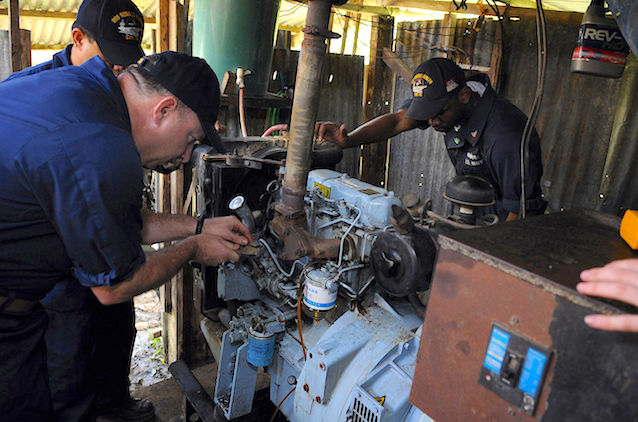5 Signs That Your Standby Generator Needs a Tune-Up
Posted by Kristopher Schwind

Purchasing and installing your standby generator is only the first step of an effective emergency power plan. Regular maintenance is a must for residential, commercial, and public facilities that rely on generators for backup power in the event of an outage.
So how do you know when your generator needs some TLC? Don’t get caught in the dark. Keep an eye out for these signs that your generator needs a tune-up:
Your generator won’t start up.
This is the most obvious sign that your standby generator is malfunctioning. A few common causes include:
- Battery Failure
- Low Fuel Levels
- Air Bubbles in the Diesel Injectors
If you’re experiencing battery failure, it’s likely due to a buildup of lead sulfates on the plates of your battery. Low fuels levels will require refueling by a professional. Air bubbles typically occur in generators if the unit’s fuel levels were low or empty.
You see an odd-colored puddle of liquid during inspection.
If you see any suspicious puddles around your generator, check coolant levels—you may be experiencing a leak. Other signs of coolant leaks include:
- A crusty residue around the hoses at the connection points
- A change in the color of the oil
Standby generators typically come equipped with built-in detector systems, but it’s important to conduct regular visual and technical checks in case any faults go undetected.
Luckily, many new standby generator models come with a “SERVICE IN” countdown meter display that reminds you when scheduled maintenance is due so you can avoid running into a backup failure.
Older standby generators may not have a “SERVICE IN” display—another reason to consider upgrading your commercial or residential unit.
Your generator is smoking or spurting flames.
If you see any signs of smoke from your standby generator, shut it off immediately.
Smoke could mean a couple of different things—oil leaks, a blown head gasket, an ineffective crankcase breather—but if there’s smoke, there’s always the possibility of fire. Needless to say, if your standby generator is on fire, there’s definitely something wrong.
In the event of a fire, call your local fire department to safely extinguish the flames. In any case, call a professional to check out your generator, and once you’ve resolved the issue, be sure to schedule regular maintenance checks to avoid a recurring problem.
Your generator is making strange noises.
All standby generators generate a certain amount of noise—though there are certain low-noise models that keep the volume down—but if you hear any irregular sputtering, coughing, or popping, you likely have a problem.
Your generator engine may be misfiring or backfiring. There are a number of potential causes—faulty ignition timing, worn plugs or cables, low fuels—but it’s impossible to diagnose without having an experienced professional taking a look at the engine system as a whole.
You see alarm lights are on or blinking.
If your standby generator comes with a fault detection system, then you will see fault codes on the control panel and on the remote monitor (if your system comes equipped with one).
These can include (but aren’t limited to) the following:
- Generator Over Voltage
- Generator Under Voltage
- Underspeed/Fail to Transfer
- Engine Fails to Start
- Low Battery Voltage
- Low Voltage
- Low Frequency
- High Engine Temperature
- Low Oil Pressure
- Overcrank
- Overspeed
- RPM Sensor Loss
- Internal Fault
- Low Fuel Pressure (QT only)
- Wiring Error
- External common fault alarm
- Overload Warning/Cooldown
- Charger Warning
- Charger Missing AC
- Stepper Over Current
- Fuse Problem
- Radio Signal Indication
- Low Air Pressure
- Emission Related Fault
Your product manual may help identify the cause of the problem, but leave any repairs to the professionals. Consider signing up for a residential service contract or commercial maintenance plan with a reputable generator company to ensure your generator is in top shape—and stays that way.
In the meantime, to avoid potential shutdowns, remember the following:
- Always maintain an appropriate oil level.
- Keep your battery connections clean and tight.
- Replace your batteries every 3 to 4 years.
- Keep the air inlet and outlet openings clear.
And most importantly…
- Be diligent with your maintenance plan.
Stick to your scheduled inspections, and be sure to check your generator system as a whole. Whether you’re dealing with a commercial or residential standby generator, the best way to ensure you’re conducting thorough maintenance is by hiring a professional.
Kristopher Schwind is the proud owner of National Standby Repair.
 24/7 EMERGENCY GENERATOR SERVICE
24/7 EMERGENCY GENERATOR SERVICE REQUEST A QUOTE
REQUEST A QUOTE
 (914) 734-1400
(914) 734-1400